No matter what field you work in—whether you’re a student, a freelancer, a full-time employee, or an entrepreneur—knowing how to network effectively can open doors for you.
With email, LinkedIn, Twitter, and offline events, you’ve got more tools and options for creating valuable connections today than ever before.
Whether we admit it or not, there’s a ceiling to what we can accomplish and how far we can go alone.
It’s only when we connect and collaborate with others that we can really climb to new heights.
What is networking?

Networking isn’t an extroverts-only game. Nor does it have to be completely selfish or “fake”. It’s also a lot easier in our increasingly connected world.
Networking today is about establishing meaningful relationships with people to help you further your own career or pursue a venture by collaborating with others.
Networking is useful for almost everyone because it enables you to:
- Find job opportunities or people who can fill roles you need to hire for yourself.
- Make contacts for potential co-marketing opportunities.
- Pursue learning opportunities through mentorship and mastermind groups.
- Get into the habit of building professional relationships over the course of your career.
- Create new friendships with like-minded people.
But before we get into how you can network more effectively, here are some tips to help guide your approach.
The rule of reciprocity
Self-interest is the basis of many decisions and relationships we make. So why do new business interactions and cold outreach attempts throw this simple truth to the wind?
Reciprocity is one of the principles of persuasion highlighted in psychologist Robert Cialdini's book Influence, which states that people have a tendency to want to repay or give back to those who give to them.
For example, taking someone out for a cup of coffee or a beer is a simple offer that can help you earn a face-to-face interaction. Offering a blogger a free sample when you reach out to them is more likely to lead to a review.
“What’s in it for me?” is a question we often ask ourselves in one way or another. And it’s a good one to get into the habit of asking from your prospect's perspective.
If you really want to create a connection with someone, especially if they can do more for you than you can for them, be accommodating and aware of the value of their time.
Sharing your network with others
The quality of your connections generally trumps quantity. A drawer full of business cards isn’t a sign of the well-connected person. Instead, what matters is the quality of the actual relationships you have with the people in your network.
Evolutionary psychologist Robin Dunbar has found that there’s a limit on the number of meaningful relationships we can maintain at once and that number is around 150. This includes your professional network, so it's no wonder we trade and borrow these relationships all the time.
Maybe you know someone who does product photography/front-end web development/logo design/content writing who you can hit up if you or someone you know is in need of a particular talent.
Or maybe you’re on good terms with someone who’s well-connected with a company that might be of interest to you and who could make an introduction.
These relationships, like all relationships, need to be maintained. Just checking in to ask how someone's doing can go a long way.
Building your network lets you participate in the natural exchange of contacts, favors, and skills between people that occurs all the time in the professional world.
Become more interesting by starting things
Whether it’s starting a blog, a YouTube channel, or a side business, doing things outside of your main job makes networking a lot easier. Not only does it make you more interesting as a person, and gives you more to talk about, but it also helps you make connections in the process as you try to grow something on your own.
Publishing, in particular, is an effective, low commitment way of making new connections—especially if you do it on platforms like LinkedIn or Medium that give you access to their built-in audiences. It helps you grow your personal brand too.
Think about what makes you interesting and different and craft it into an elevator pitch to keep in your back pocket for when you need to introduce yourself.
Everyone’s got a story that makes them unique, that they can tap into, but if you're stuck on where to start, here's a template that I strongly encourage you to adapt based on your own story, who you're talking to, and whether it's in person or online.
Elevator Pitch Template:
My name is [YOUR NAME], [TITLE] at [YOUR COMPANY]. We offer [PRODUCT/SERVICE] for [TARGET MARKET] to [VALUE PROPOSITION].
Unlike [THE COMPETITION], we [KEY DIFFERENTIATOR]. And we recently [RECENT MILESTONE].
Example:
My name is Braveen Kumar, a Content Creator at Shopify. We offer a platform that empowers both early entrepreneurs and large enterprises to build, run, and grow their own stores.
Unlike most marketplaces where you can sell your products, Shopify lets you build and brand your custom online store with the tools to sell across a variety of channels, manage inventory, start small, and scale fast.
Today, over 500,000 entrepreneurs use Shopify to power their businesses.
How to network in today's world
Networking today isn't what it used to be. It's a whole lot better and easier for anyone to do.
In today's connected world we've got more opportunities to build new local and remote relationships by:
- Harnessing the power of cold emailing.
- Being social on social media to make connections within your network.
- Seeking out offline networking opportunities to meet new people.
- Showcasing your personality and what you care about online to attract people to you.
But let's start with a strategy that often goes under-appreciated or poorly executed: cold emailing.
The fine art of cold emailing
Email might be old and your outreach is oftentimes cold, but it’s still one of the most powerful ways to connect with new people—especially if you apply the following tools and tactics.
How to find (almost) any email address
The hardest part of email outreach can be getting your hands on the contact info you need. Not everyone makes their email address available to the public.
Clearbit Connect offers a free Gmail extension that will help you search for contacts by organization to find the business emails of people you might want to reach out to.
You can use it to help you reach writers at a specific publication, marketers who might be willing to partner with you, founders of specific companies, and potential mentors you’d like to learn from.
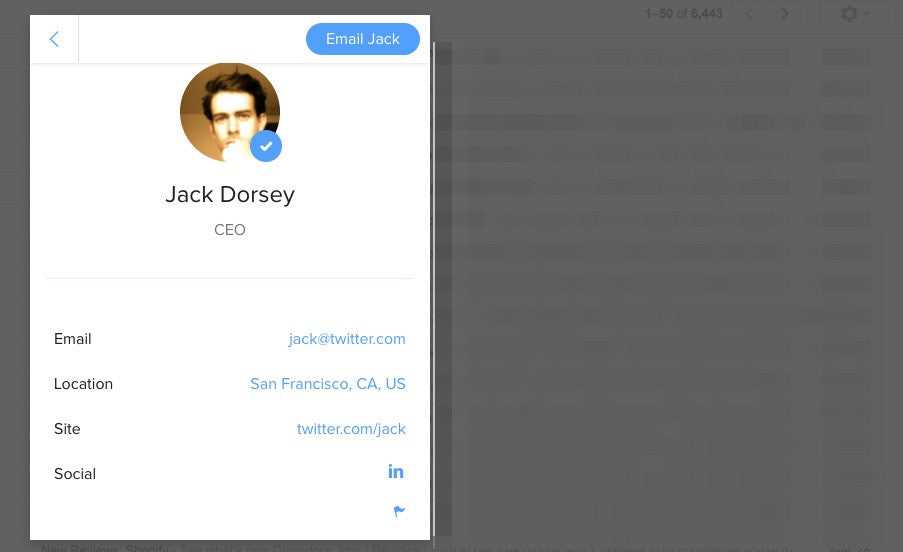
Alternatively, if that fails and you can’t find the email of a specific contact, you can turn to social media (more on that later) or ask for an introduction from a mutual connection if you happen to share one with the person you want to connect with.
Choosing a shotgun vs. rifle approach to cold emailing
There are essentially two ways to approach cold emailing.
A “shotgun approach” to cold emailing trades personalization and targeted messaging in favor of reaching more people with a single email. You won't know who, if anyone, will answer so it easily becomes about how many contacts you reach out to.
I’d only ever recommend this approach if you want to notify a large group of people about something that’s truly relevant and useful to them (like a job offer or an invitation to an event).
But if you want to make a really meaningful connection, you should take the time to pursue a “rifle approach”. Do some prospect research—using Google and their social media profiles—to figure out who this person is and how best to connect with them before you reach out.
Are they up to a lot of cool things? Do you have a shared interest, like snowboarding? The more you know, the better equipped you’ll be when you email them. A genuine email that shows research is how you prove you’re not just one of the many mass emails that they get every day.
Either way, I recommend using a free tool like Streak CRM to:
- Personalize your mass emails based on fields like first name and company name.
- Save templates to customize in the future.
- Keep track of who you’ve emailed and make notes about your contacts.
- See if they even opened your emails—incredibly valuable insight that can help inform any follow-up you do.
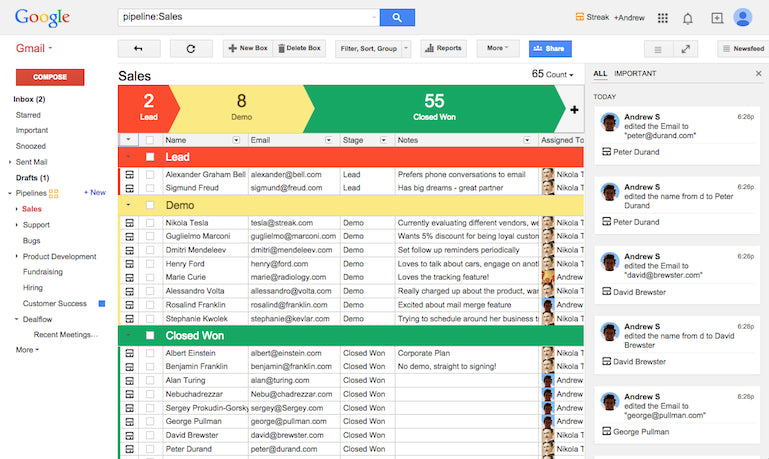
Email outreach can be hit or miss and that’s okay. Just be sure you craft a good email because, as they say, you’ve only got one shot at making a first impression.
How to craft a good cold email
Every cold email you send has 3 goals:
- To get opened.
- To get read.
- To call the recipient to take some sort of action.
In order to ensure your email is opened, your subject line should be short, compelling, and clear—you only have about half the length of a 140-character tweet.
Anything over 78 characters is sure to get cut off in your recipient's inbox, and you’ve got even less room when you consider the reduced character limit on mobile and that 53% of emails are opened on people’s phones. Think about how you can quickly stand out amongst the deluge of promotional and work emails we all have to deal with.
Timing is also important. Think about when people are generally at their computers checking their email: work days (Monday to Friday) in the mornings.
As for writing the body of the email, make sure you do the following:
- Introduce yourself and what it is about the person that compelled you to reach out.
- Deliver a quick elevator pitch to offer some background info about you.
- Lay out the next step (to connect, to offer feedback, to learn more on your website, etc.)
- Don't use more words than you need and break up the text into small paragraphs—busy people don't have time to read.
One of the biggest mistakes people often make with cold emails is making it all about themselves rather than the person they’re reaching out to. A good cold email proves that you took the time to do your research about the person.
Adding a little personality can also go a long way in differentiating you from all the other emails in their inbox and earning a response—whether that means adding an emoji in the subject line or a GIF in the body if you think your contact would appreciate a little fun.
Steal These 7 FREE Email Outreach Templates
Download these versatile and proven email outreach scripts that can be easily customized to suit your unique needs.
GET FREE TEMPLATESLeveraging your email signature
If you haven’t already, you should optimize your email signature with links to your website, LinkedIn, Twitter and other relevant social profiles to help your contacts learn more about you. You can add this automatically at the end of every email you send by setting it up in your Gmail settings.

Social networking on LinkedIn and Twitter
They wouldn't be called social networks if they weren't good for networking. And unlike email, it’s much easier for you to get in touch with people and vice versa through your public social profiles.
Your social networking strategy can essentially be broken down into two approaches:
-
Inbound: When people find you because they are intentionally searching for you or someone like you, or stumble upon you because of your public activity online.
-
Outbound: When you reach out to other people online, either through a public post or direct messaging.
For our purposes, we’ll explore two of the best social platforms for networking: LinkedIn and Twitter.
How to Use Your LinkedIn profile the right way
Many people set their LinkedIn up as an online resume and leave it at that. In reality, LinkedIn is home to 467 million professionals organized by industry, skills, and mutual connections.
Not only that, when someone searches for you on Google, LinkedIn will be one of the top results, helping you to get found both on and off the platform.
The following graphic outlines the key elements of a strong, searchable LinkedIn profile. You can see the entire infographic at Leisure Jobs to learn how to make the most of LinkedIn.
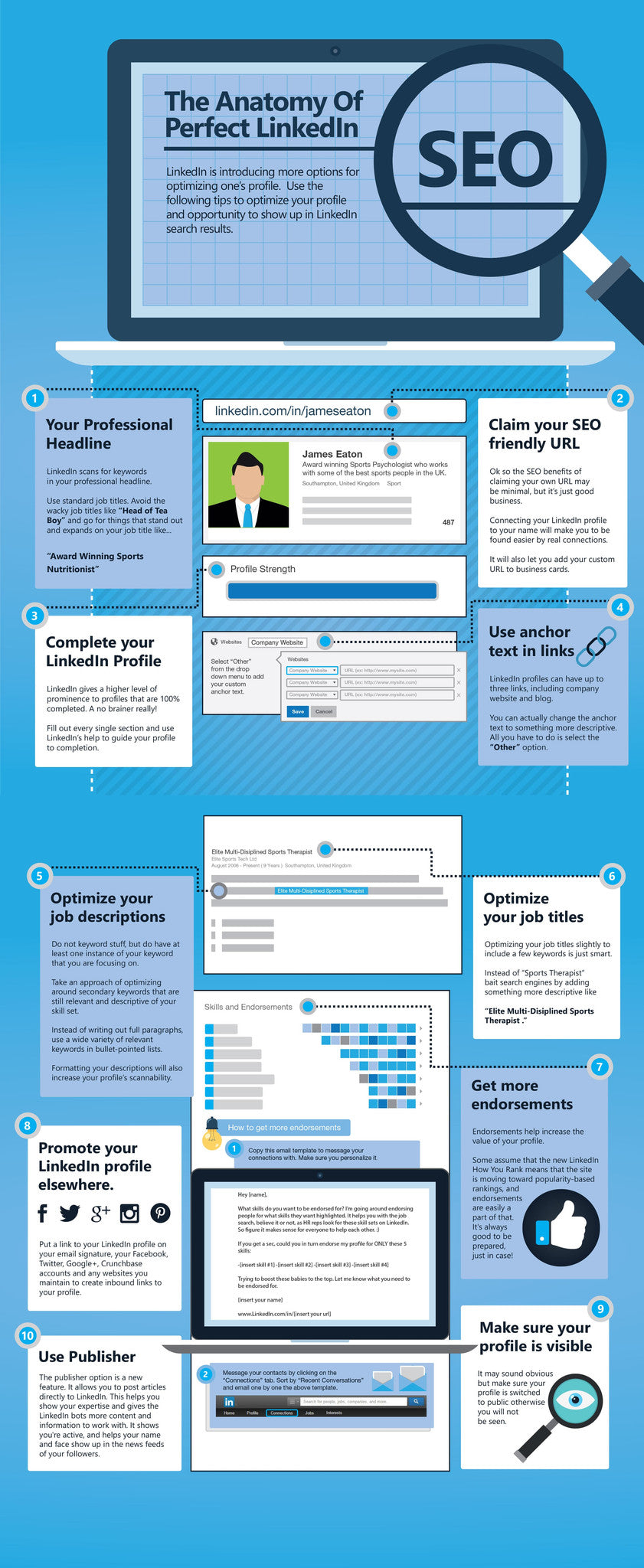
Infographic transcript:
The Anatomy of Perfect Linkedin SO Linked is introducing more options for optimizing one’s profile. Use the following tips to optimize your profile and opportunity to show up in LinkedIn search results. Your Professional Headline Linkedin scans for keywords in your professional headline Use standard job titles. Avoid wacky job titles like “head of tea boy” and go for things that stand out and expand on your job title like…”Award Winning Sports Nutritionist” 2. Claim your SEO friendly URL Ok so the SEO benefits of claiming your own URL may be minimal, but it’s just good business. Connecting your LinkedIn profile to your name will make you to be found easier by real connections. It will also let you add your custom URL to business cards. 3. Complete your LinkedIn Profile LinkedIn gives a higher level of prominence to profiles that are 100% completed. A no-brainer really! Fill out every single section and use LinkedIn’s help to guide your profile to completion. 4. Use anchor text in links Linkedin profiles can have up to three links including company website and blog. You can actually change the anchor text to something more descriptive. All you have to do is select the “Other” option. 5. Optimize your job descriptions. Do not keyword stuff, but do have at least one instance of your keyword that you are focusing on. Take an approach of optimizing around secondary keywords that are relevant to and descriptive of your skill set. Instead of writing out full paragraphs, use a wide variety of relevant keywords in bullet-point lists. Formatting your descriptions will also increase your profile’s scannability. 6. Optimize your job titles Optimizing your job titles slightly to include a few keywords is just smart. Instead of “sports therapist” bait search engines by adding something more description like “Elite Multi-Disciplined Sports Therapist”. 7. Get more Endorsements. Endorsements help increase the value f your profile. Some assume that the new LinkedIn How you Rank means that the site is moving toward popularity-based rankings and endorsements are easily a part of that. It’s always good to be prepared, just in case!. 8. Promote your LinkedIn profile elsewhere Put a link to your LinkedIN profile on your email signature, your Facebook, Twitter, Google+ , Crunchbase accounts and any websites you maintain to create inbound links to your profile. 9. Make sure your profile is visible. It may sound obvious but make sure your profile is switched to public otherwise you will not be seen. 10. Use publisher. The publisher option is a new feature. It allows you to post articles directly to LinkedIn. This helps you show your expertise and gives the LinkedIn bots more content and information to work with. It shows you’re active and helps your name and face show up in the news feeds of your followers.
LinkedIn also lets you reach out to people within your network via direct messaging. There's one caveat though. They have to be an exiting connection. You can pay to message people outside of your network using LinkedIn's InMail feature, but you have to pay for a premium plan.
When you send an invite to connect, you can increase your chances of the recipient accepting your request by customizing the message with a quick introduction and why you think the connection is worth making.
Twitter is even better than LinkedIn for networking
Twitter has always been somewhere between Facebook and LinkedIn as far as the vibe of the social platform goes. It's definitely more open to conversations that have nothing to do with work. Luckily, it leans towards LinkedIn when it comes to networking and making new connections online. In fact, in my experience, it's even better.
As a public forum, Twitter is one of the best places for talking to total strangers and finding the right ones based on the nature of the things they tweet.
Similar to LinkedIn, you should optimize your Twitter bio to convey what you do and what you're about, as well as personal tidbits that reveal your interests. Use some of the keywords that people search for (like your job title or industry) in your bio to make it easier for them to find you.
If you're looking to connect with people in a specific city, Twitter's Advanced Search can be used to search for people based on location, job title, company, or any other information that's on their profile.
Like LinkedIn, one of the hurdles on Twitter is that unless an account changes its default privacy settings, you can only send private direct messages to people who are following you.
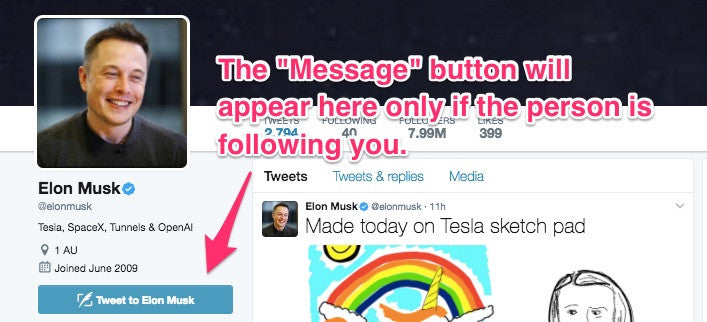
If the person you want to reach out to isn't following you, here's what you can do:
- Follow the account so that they can direct message you.
- Mention them in a tweet (using @username) to start a public conversation.
- Invite them to send you a direct message to start a conversation.
Twitter lists are an underused feature on Twitter, and incredibly useful for maintaining your relationships with the people you meet. Whereas your main Twitter feed will fast become flooded with all kinds of tweets, Lists let you focus only on the specific people you decide to add.
Create private lists that let you add the people you're interested to keep tabs on what they're up to.
Make an effort to engage with these Twitter friends—with Likes, Retweets or, better yet, conversations—not to reap something down the road but because adding them to a dedicated list means you probably respect who they are.
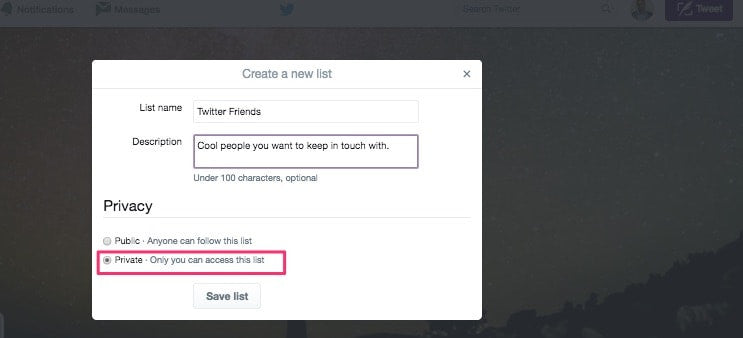
You might be wondering why Facebook isn't in this section. That's because, outside of Facebook Groups, which can be a great way to meet people with similar interests, I would caution you against messaging someone who doesn't know you directly through their personal Facebook profile, especially if it's not public.
While Twitter and LinkedIn are often used as professional channels, Facebook connections are generally reserved for friends, family, and casual acquaintances, and your cold messages might not be well-received by most people.
Connecting with people offline
Even in an increasingly online world, the best, deepest connections you’ll make are face-to-face. Offline networking events are still wildly popular—plus, they're a lot better organized now thanks to technology.
If you're interested in local events that draw other like-minded people, these platforms are among the best places to discover them:
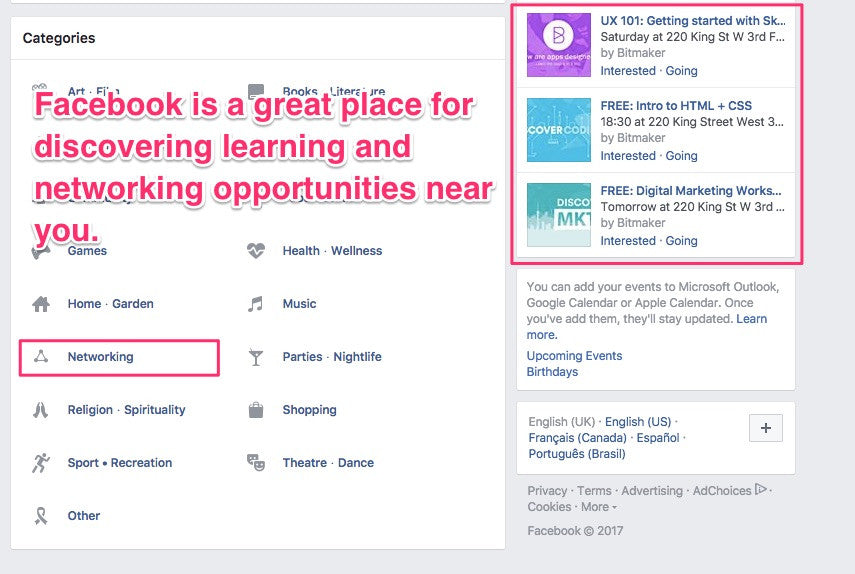
Always consider the audience of the event before you decide to attend.
While traditional networking mixers can be fun, I'd recommend attending workshops and talks instead since there's usually a meet-and-greet component anyway where you can get your networking on. Not only do you get to learn something, but you'll have a better idea of the kind of people who will come out as the audience for these events is usually more targeted.
Be strategic about the nature of the event. If you'd like to meet Instagram influencers, for example, you might want to attend an Instameet near you.
Of course, we can't talk about offline networking without mentioning business cards.
Are business cards still important when someone can just look you up online?
Yes. Not only is swapping business cards faster and more personal than exchanging contact information over your phones, it shows you came ready to make connections, condenses your personal brand into a pocket-sized card, and invites others to contact you and tells them how.
You can generate your own designs fast and for free with our online Business Card Maker, now available in the Play Store as the Business Card Maker app.

Networking for introverts
While more outgoing people often flourish in networking environments, if you're on the introverted end of the social spectrum (like me), here are some tips that'll make your life easier:
- Everyone who's there is there to meet new people. All you need to do is say, "Hey, what's up?" and introduce yourself. When someone gives you their name, repeat it back to them to help you remember it.
- Ask questions and actively listen to the other person. It's a good way to get a conversation started if it takes you some time to warm up to new people. Plus, you let them do most of the talking.
- Don't be afraid to move on. Simply say that it was nice to meet the person and that you're going to make your way around the room, shake hands and exchange business cards or contact information if you'd like to keep in touch.
- Small talk is always avoidable as long as you take the initiative.
Small talk requires permission from both parties for it to happen.
It's also important to remember that you're under no obligation to stay for the entire event. If you're just not having a good time, there's always next time.
Networking opens doors for you
Learning how to network effectively isn't just a skill for the world of business.
Putting yourself out there and making connections can help you build your career, find mentors, new friends, develop your own venture, and open doors in the future.
They say, "It's not just what you know, but who you know." But that's a shallow way to look at these relationships. It's more like we're all just puzzle pieces with different needs that fit together at different times.
Sometimes you "know a person" that someone else needs. Sometimes you need them. Sometimes you are that person to someone else. But you can only benefit from having these connections if you invest the time into building your network.

